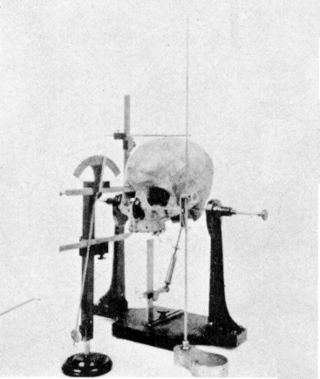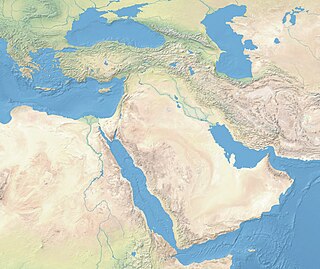Related Research Articles

Anthropometry refers to the measurement of the human individual. An early tool of physical anthropology, it has been used for identification, for the purposes of understanding human physical variation, in paleoanthropology and in various attempts to correlate physical with racial and psychological traits. Anthropometry involves the systematic measurement of the physical properties of the human body, primarily dimensional descriptors of body size and shape. Since commonly used methods and approaches in analysing living standards were not helpful enough, the anthropometric history became very useful for historians in answering questions that interested them.

Forensic anthropology is the application of the anatomical science of anthropology and its various subfields, including forensic archaeology and forensic taphonomy, in a legal setting. A forensic anthropologist can assist in the identification of deceased individuals whose remains are decomposed, burned, mutilated or otherwise unrecognizable, as might happen in a plane crash. Forensic anthropologists are also instrumental in the investigation and documentation of genocide and mass graves. Along with forensic pathologists, forensic dentists, and homicide investigators, forensic anthropologists commonly testify in court as expert witnesses. Using physical markers present on a skeleton, a forensic anthropologist can potentially determine a person's age, sex, stature, and race. In addition to identifying physical characteristics of the individual, forensic anthropologists can use skeletal abnormalities to potentially determine cause of death, past trauma such as broken bones or medical procedures, as well as diseases such as bone cancer.
Osteology is the scientific study of bones, practised by osteologists. A subdiscipline of anatomy, anthropology, and paleontology, osteology is the detailed study of the structure of bones, skeletal elements, teeth, microbone morphology, function, disease, pathology, the process of ossification, and the resistance and hardness of bones (biophysics).

Bone age is the degree of a person's skeletal development. In children, bone age serves as a measure of physiological maturity and aids in the diagnosis of growth abnormalities, endocrine disorders, and other medical conditions. As a person grows from fetal life through childhood, puberty, and finishes growth as a young adult, the bones of the skeleton change in size and shape. These changes can be seen by x-ray and other imaging techniques. A comparison between the appearance of a patient's bones to a standard set of bone images known to be representative of the average bone shape and size for a given age can be used to assign a "bone age" to the patient.
The term bioarchaeology has been attributed to British archaeologist Grahame Clark who, in 1972, defined it as the study of animal and human bones from archaeological sites. Redefined in 1977 by Jane Buikstra, bioarchaeology in the United States now refers to the scientific study of human remains from archaeological sites, a discipline known in other countries as osteoarchaeology, osteology or palaeo-osteology. Compared to bioarchaeology, osteoarchaeology is the scientific study that solely focus on the human skeleton. The human skeleton is used to tell us about health, lifestyle, diet, mortality and physique of the past. Furthermore, palaeo-osteology is simple the study of ancient bones.

Mildred Trotter was an American pioneer as a forensic historian and forensic anthropologist.

Forensic facial reconstruction is the process of recreating the face of an individual from their skeletal remains through an amalgamation of artistry, anthropology, osteology, and anatomy. It is easily the most subjective—as well as one of the most controversial—techniques in the field of forensic anthropology. Despite this controversy, facial reconstruction has proved successful frequently enough that research and methodological developments continue to be advanced.
FORDISC is a software program created by Stephen Ousley and Richard Jantz. It is designed to help forensic anthropologists investigate the identity of a deceased person by providing estimates of the person's size, ethnicity, and biological sex based on the osteological material recovered.

Cephalometry is the study and measurement of the head, usually the human head, especially by medical imaging such as radiography. Craniometry, the measurement of the cranium (skull), is a large subset of cephalometry. Cephalometry also has a history in phrenology, which is the study of personality and character as well as physiognomy, which is the study of facial features. Cephalometry as applied in a comparative anatomy context informs biological anthropology. In clinical contexts such as dentistry and oral and maxillofacial surgery, cephalometric analysis helps in treatment and research; cephalometric landmarks guide surgeons in planning and operating.

Skeletonization is the state of a dead organism after undergoing decomposition. Skeletonization refers to the final stage of decomposition, during which the last vestiges of the soft tissues of a corpse or carcass have decayed or dried to the point that the skeleton is exposed. By the end of the skeletonization process, all soft tissue will have been eliminated, leaving only disarticulated bones.
The University of Tennessee Anthropological Research Facility, better known as the Body Farm and sometimes seen as the Forensic Anthropology Facility, was conceived in 1971 and established in 1972 by anthropologist William M. Bass as the first facility for the study of decomposition of human remains. It is located a few miles from downtown Knoxville, Tennessee, US, behind the University of Tennessee Medical Center, and is part of the Forensic Anthropology Center, which was established by Dr. Bass in 1987.
Richard L. Jantz is an American anthropologist. He served as the director of the University of Tennessee Anthropological Research Facility from 1998–2011 and he is the current Professor Emeritus of the Department of Anthropology at the University of Tennessee, Knoxville. His research focuses primarily on forensic anthropology, skeletal biology, dermatoglyphics, anthropometry, anthropological genetics, and human variation, as well as developing computerized databases in these areas which aid in anthropological research. The author of over a hundred journal articles and other publications, his research has helped lead and shape the field of physical and forensic anthropology for many years.
The Phenice method is a technique of determining the sex of a human skeleton from the innominate pelvis. In the procedure, sex is determined based on three features: the ventral arc, the subpubic concavity, and the medial aspect of the ischio-pubic ramus. As a non-metric absolute method, it relies on the recognition of discrete male and female traits. This makes the method objective, easily performable, and relatively quick. It is considered highly accurate, up to 96%, owing to the distinct biological differences between male and female anatomy in the pelvis, making it a highly useful method for those determining the sex of a skeleton.

CranID was created in 1992 by anthropologist Richard Wright of the University of Sydney to infer the probable geographic origin of unknown crania that are found in archaeological, forensic and repatriation cases. Wright created the program to establish uniformity in cranial morphology based on the assumption that there is a high correlation between geographical location and cranial morphology. This was the first standardized program to evaluate the similarity and dissimilarity of cranial morphological characteristics of an unknown cranium and the database.
Osteoware is a free data recording software for human skeletal material that is managed through the Smithsonian Museum of Natural History. It is used by biological anthropologists to document data relevant to research and forensic applications of human skeletal remains in a standardized and consistent way. It has influenced other skeletal recording software, and has been successfully used at the Smithsonian for collecting data relevant to biological anthropology. Osteoware is the only free, individual-use software for the collection of data on skeletal material in anthropology.

Forensic estimation of stature is part of the identification process necessary when dismembered body parts are found. It is also possible to estimate the stature from bones. Even measurements of body parts of body such as a finger can be used to estimate the stature.
Mortuary archaeology is the study of human remains in their archaeological context. This is a known sub-field of bioarchaeology, which is a field that focuses on gathering important information based on the skeleton of an individual. Bioarchaeology stems from the practice of human osteology which is the anatomical study of skeletal remains. Mortuary archaeology, as well as the overarching field it resides in, aims to generate an understanding of disease, migration, health, nutrition, gender, status, and kinship among past populations. Ultimately, these topics help to produce a picture of the daily lives of past individuals. Mortuary archaeologists draw upon the humanities, as well as social and hard sciences to have a full understanding of the individual.
Lucile Eleanor St. Hoyme was an American biological anthropologist who conducted research related to human variation, bioarcheology, and paleopathology. St. Hoyme served as an Assistant Curator in the Department of Anthropology at the National Museum of Natural History. St. Hoyme analyzed human remains excavated from the John Kerr Reservoir Basin using a new bioarcheological approach combining data from other disciplines. Beyond her work with the Smithsonian collections, St. Hoyme also worked on FBI forensic cases in the 1960s with National Museum of Natural History Anthropology Curator J. Lawrence Angel.

Near Eastern bioarchaeology covers the study of human skeletal remains from archaeological sites in Cyprus, Egypt, Levantine coast, Jordan, Turkey, Iran, Saudi Arabia, Qatar, Kuwait, Bahrain, United Arab Emirates, Oman, and Yemen.
Goldine C. Gleser was an American psychologist and statistician known for her research on the statistics of psychological testing, on generalizability theory, on defence mechanisms, on the psychological effects on child survivors of the Buffalo Creek flood, for her work with Mildred Trotter on estimation of stature, and for her participation in the Cincinnati Radiation Experiments. She was a professor of psychiatry and psychology at the University of Cincinnati.
References
- 1 2 3 Robert J. Terry Anatomical Skeletal Collection, National Museum of Natural History, Smithsonian Institution, USA.Hunt, D.R. and J. Albanese 2005 History and demographic composition of the Robert J. Terry Anatomical Collection. American Journal of Physical Anthropology 127:406-417.
- 1 2 Trotter, Mildred; Gleser, Goldine C. (1952). "Estimation of stature from long bones of American Whites and Negroes" (PDF). American Journal of Physical Anthropology. 10: 463–514. doi:10.1002/ajpa.1330100407. PMID 13007782.
- ↑ Blau, Soren; Ubelaker, Douglas H. (2009). Handbook of Forensic Archaeology and Anthropology. Walnut Creek, CA: Left Coast Press INC. pp. 191–195. ISBN 978-1-61132-793-9.
- ↑ Novak, Lauren; Schultz, John J.; McIntyre, Matthew (2012). "Determining Sex of the Posterior Ilium from the Robert J. Terry and William M. Bass Collections". Journal of Forensic Sciences. 57 (5): 1155–1160. doi:10.1111/j.1556-4029.2012.02122.x.
- ↑ Kindschuh, Sarah C.; Dupras, Tasha L.; Cowgill, Libby W. (2012). "Exploring Ancestral Variation of the Hyoid". Journal of Forensic Sciences. 57 (1): 41–46. doi:10.1111/j.1556-4029.2011.01962.x.
- ↑ Albanese, John (2013). "A Method for Estimating Sex Using the Clavicle, Humerus, Radius, and Ulna". Journal of Forensic Sciences. 58 (6): 1413–1419. doi:10.1111/1556-4029.12188.
- ↑ "UT Knoxville | Forensic Anthropology Center | Forensic Anthropology Data Bank". fac.utk.edu. Archived from the original on 2015-10-29. Retrieved 2015-11-15.
- ↑ "FORDISC Help File Version 1.35" (PDF). math.mercyhurst.edu. n.d. Retrieved November 15, 2015.
- ↑ "Fordisc 3 home page". math.mercyhurst.edu. Retrieved 2015-11-15.
- ↑ Işcan, M. Y. (1983-10-01). "Assessment of race from the pelvis". American Journal of Physical Anthropology. 62 (2): 205–208. doi:10.1002/ajpa.1330620210. ISSN 0002-9483. PMID 6650681.
- ↑ Killgrove, Kristina (2009). "Rethinking Taxonomies: Skeletal Variation on the North Carolina Coastal Plain". Southeastern Archaeology. Retrieved 19 Nov 2015.
- ↑ "NCUR". ncurdb.cur.org. Retrieved 2015-11-15.
- 1 2 3 Yurka, Laura Natalie (2014-01-01). An Evaluation of Metric Methods of Race Differentiation in the Human Pelvic Girdle for the Application of Expert Witness Testimony.
- ↑ Albanese, John; Osley, Stephanie E.; Tuck, Andrew (2012-06-10). "Do century-specific equations provide better estimates of stature? A test of the 19-20th century boundary for the stature estimation feature in Fordisc 3.0". Forensic Science International. 219 (1–3): 286.e1-3. doi:10.1016/j.forsciint.2011.11.026. ISSN 1872-6283. PMID 22206715.
- Glade (Green), Amber M. (2001). A study of long bone fracture patterns in the Robert. J. Terry Collection, Smithsonian Institution. Durham University. Department of Archaeology, Division of Paleopathology.